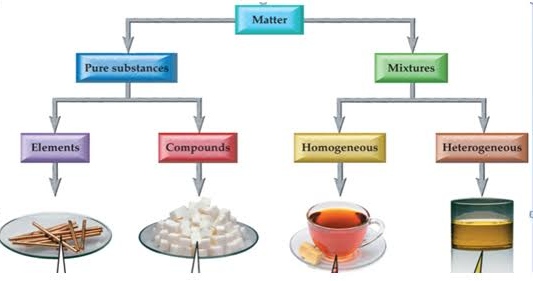Question 1. What is meant by a substance?
Answer: A pure substance consists of a single type of particles.
Question 2. List the points of differences between homogeneous and heterogeneous mixtures.
Answer:

Question 1. Differentiate between homogeneous and heterogeneous mixtures with examples.

Question 2. How are sol, solution and suspension different from each other?
Answer:

Question 3. To make a saturated solution, 36 g of sodium chloride is dissolved in 100 g of water at 293 K. Find its concentration at this temperature.
Answer: Mass of solute (sodium chloride) = 36 g
Mass of solvent (water) = 100 g
Mass of solution = Mass of solute + Mass of solvent
= 36 g + 100 g = 136 g.

Question 1. How will you separate a mixture containing kerosene and petrol (difference in their boiling points is more than 25°C), which are miscible with each other?
Answer: A mixture of kerosene and petrol which are miscible with each other can be separated by distillation.
Method.

Question 2. Name the technique to separate
(i) butter from curd ?
Ans: (Centrifugation )
(ii) salt from sea-water ?
Ans : (Evaporation )
(iii) camphor from salt?
Ans 🙁 Sublimation )
Question 3. What type of mixtures are separated by the technique of crystallisation?
Answer: Crystallisation technique is used to purify solid with some impurities in it. Example: Salt from sea-water.
Question 2. Classify the following as chemical or physical changes:
Answer:

Physical change
- Cutting of trees
- Melting of butterbutter in a pan.
- Boiling of water to form steam.
- Dissolving common salt in water
- Making a fruit salad with raw fruits
Chemical Change:*Rusting of Almirah
*Rusting of Almirah
*Passing of electric CurrentCurrent
*Burning of Paper and wood
Question 3. Try segregating the things around you as pure substances or mixtures.
Answer: Pure substances—Water, bread, sugar and gold.
Mixtures—Steel, plastic, paper, talc, milk and air.
Question 1. Which separation techniques will you apply for the separation of the following?
Answer:
(a) Evaporation
(b) Sublimation
(c) Filtration
(d) Chromatography
(e) Centrifugation
(f) Separating funnel
(g) Filtration
(h) Magnetic separation
(i) Winnowing/ sedimentation
(j) Decantation and filtration
Question 2. Write the steps you would use for making tea. Use the words, solution, solvent, solute, dissolve, soluble, insoluble, filtrate and residue.
Answer: 1. Take a cup of water in a container as asolvent and heat it.
- Add sugar which is solute. Heat till all sugar dissolves Completely.
- We get a solution of water and sugar.
- Sugar is soluble in water completely.
- Add half a tea-spoon of tea-leaves, it is insoluble in water.
- Boil the content, add milk which is also soluble in water.
- Filter the tea with the help of strainer, the tea collected in cup is filtrate and the tea leaves collected on the strainer is residue.
Question 3. Pragya tested the solubility of three different substances at different temperatures and collected, the data as given below (results are given in the following table, as grams of substance dissolved in 100 grams of water to form a saturated solution).
(a) What mass of potassium nitrate would be needed to produce a saturated solution of potassium nitrate in 50 grams of water at 313 K?
(b) Pragya makes a saturated solution of potassium chloride in water at 353 K and leaves the solution to coo! at room temperature. What would she observe us the solution cools?
Answer: Homework but not important.
Question 4. Explain the following giving examples:
(a) Saturated solution
(b) Pure substance
(c) Colloid
(d) Suspension
Answer: (a)
Saturated solution: In a given solvent when no more solute can dissolve further at a given temperature is called saturated solution.
(b) Pure substance:
A pure substance consists of a single type of particles. E.g., gold, silver.
(c) Colloid:
A colloid is a solution in which the size of solute particles are bigger than that of true solution. These particles cannot be seen with our naked eyes, they are stable, e.g., ink, blood.
(d) Suspension:
It is a heterogeneous mixture in which the solute particles are big enough to settle down, e.g., chalk-water, paints, etc.
Question 5. Classify each of the following as a homogeneous or heterogeneous mixture: soda water, wood, air. soil, vinegar, filtered tea.
Answer: Homogeneous: Soda water, vinegar, filtered tea.
Heterogeneous: Wood, air, soil.
Question 6. How would, you confirm that a colourless liquid given to you is pure water?
Answer: By finding the boiling point of a given colourless liquid. If the liquid boils at 100°C at atmospheric pressure, then it is pure water. This is because pure substances have fixed melting and boiling point.
Question 7. Which of the following materials fall in the category of a “pure substance”?
Answer: Pure substances are: Ice, iron, hydrochloric acid, calcium oxide and mercury.
Question 8. Identify the solutions among the following mixtures.
Answer: Solutions are: Sea water soda water and air.
Question 9. Which of the following will show “Tyndall effect”?
Answer: Milk and starch solution.
Question 10. Classify the following into elements, compounds and mixtures.
Answer:
*Elements – Compounds – Mixtures
Sodium – Calcium carbonate – Sugar solution
* Silver – Methane – Soil
* Tin – Carbon dioxide – Coal
* Silicon – Soap – Air ,Blood
Question 11. Which of the following are chemical change ?.
Answer: Chemical changes are:
(a) Growth of a plant (b) Rusting of iron
(c) Cooking of food (d) Digestion of food
(e) Burning of a candle.

Chapter 2 Important terms to remember:
Very Short Answer Questions
Question 1. Define solvent.
Answer: The component of the solution that dissolves the other component in it is called the solvent.
Question 2. Define solute.
Answer: The component of the solution that is dissolved in the solvent is called solute.
Question 3. What are alloys?
Answer: The homogeneous mixture of two or more metals or a metal and non-metal is called an alloy. E.g., steel is an alloy of iron and carbon.
Question 4. What is “concentration of a solution”?
Answer: The concentration of a solution is the amount of solute present in a given amount of solution or the amount of solute dissolved in a given mass or volume of solvent.
Question 5. State the difference between aqueous and, non-aqueous solution.
Answer: Aqueous solutions have water as solvent and non-aqueous solutions do not haVe water as solvent.
Question 6. What is “solubility” of a solute?
Answer: The amount of the solute present in the saturated solution at the given temperature is called its solubility.
Question 7. What is saturated solution?
Answer: The maximum amount of solute dissolved in a solvent at given temperature is called saturated solution, where no more solute can dissolve further.
Question 8. What is unsaturated solution?
Answer: If the amount of solute contained in a solution is less than the saturation level, it is called an unsaturated solution.
Question 9. Why water is called universal solvent?
Answer: Water can dissolve large number of substances in it.
Question 10. What is Tyndall effect?
Answer. The scattering of light by colloidal particles is known as Tyndall effect.
Question 11. How can we separate colloidal mixtures?
Answer: By centrifugation, in a centrifuge machine the colloidal solution is kept in a test tube, rotated very fast and due to centrifugal force the colloidal particles are separated.
Question 12. What is emulsion?
Answer: When both the dispersed phase and dispersing medium is liquid, it is called emulsion. E.g., milk, face cream.
Question 13. What is aerosol?
Answer. When the solid or liquid is dispersed in a gas it is called aerosol. E.g., smoke, fog.
Question 14. What is the principle for separation of immiscible liquids?
Answer: The principle of separating immiscible liquids into layers depending on their densities. The less denser liquid collects at the top and more denser liquid at the bottom. ‘
Question 15. What is chromatography?
Answer: Chromatography is the technique used for separation of those solutes that dissolve in the same solvent.
Question 16. What is distillation?
Answer: Distillation is the separation technique of two miscible liquids that boils without decomposition and have sufficient difference in their boiling points.
Question 17. How can you separate two liquids that have less than 25 K difference of boiling points?
Answer: To separate a mixture of two or more miscible liquids for which the difference in boiling points is less than 25 K, is fractional distillation.
Question 18. What is condenser?
Answer: It is an apparatus used to convert gas into liquid by cooling it.
Question 19. What is crystallisation?
Answer: When a saturated solution is heated and allowed to cool slowly, crystal of the solute dissolved in the saturated solution are separated from it. It is used to purify solids.
Question 20. Why is mixture called impure substance?
Answer: Mixture consists of different components which retain their properties and can be easily separated by physical processes, hence it is called as impure substance.
Question 21. State the properties of a solution.
Answer: Properties of a solution are:
A solution is a homogeneous mixture.
Particles of a solution are smaller than 1 nm and cannot be seen by naked eyes.
Do not scatter beam of light.
Solute particles cannot be separated from the mixture by the process of filtration and thus, solution is stable.
Question 22. State the properties of a suspension.
Answer: Properties of a suspension
Suspension is a heterogeneous mixture having particle size greater than 100 nm.
The particles of a suspension can be seen by naked eyes.
Particles can scatter a beam of light.
It is unstable.
Question 23. What is a colloidal solution?
Answer: It is a heterogeneous solution which appears to be homogeneous, particles size is very small and so cannot be seen with naked eyes but it is stable. E.g., milk and blood.
Question 24. State the properties of colloidal solution.
Answer: Properties of colloidal solution.
It is a heterogeneous mixture having particle size between 1 nm to 100 nm.
Size of particles is very small, cannot be seen with naked eyes.
It scatters a beam of light.
They are stable as the particles do not settle when left undisturbed.
Question 25. Give the applications of centrifugation.
Answer: Application of centrifugation are:
Used in diagnostic laboratories for blood and urine test.
Used in dairies and home to separate butter from cream.
Used in a washing machines to squeeze out water from wet clothes.
Question 26. Give the applications of chromatography.
Answer: Applications of chromatography are
To separate colours in a dye.
To separate pigments from natural colours.
To separate drugs from blood.
Question 27. Why is crystallisation better than evaporation?
Answer: Crystallisation is a process that separates a pure solid in the form of its crystals from a solution. Crystallisation is better than evaporation because during Evaporation
Some solids decompose or some, like sugar may get charred on heating to dryness.
Some impurities may remain dissolved in the solution even after filtration which on evaporation contaminates the solid.
Question 28. How will you separate a mixture of oil and water?
Answer: To separate a mixture of oil and water, we need a separating funnel as both are immiscible liquids. Pour the mixture in separating funnel and let the funnel stand undisturbed for sometime. So that separate layer of oil and water are formed. Open the stopcock of the separating funnel and pour out the lower layer of water carefully.

